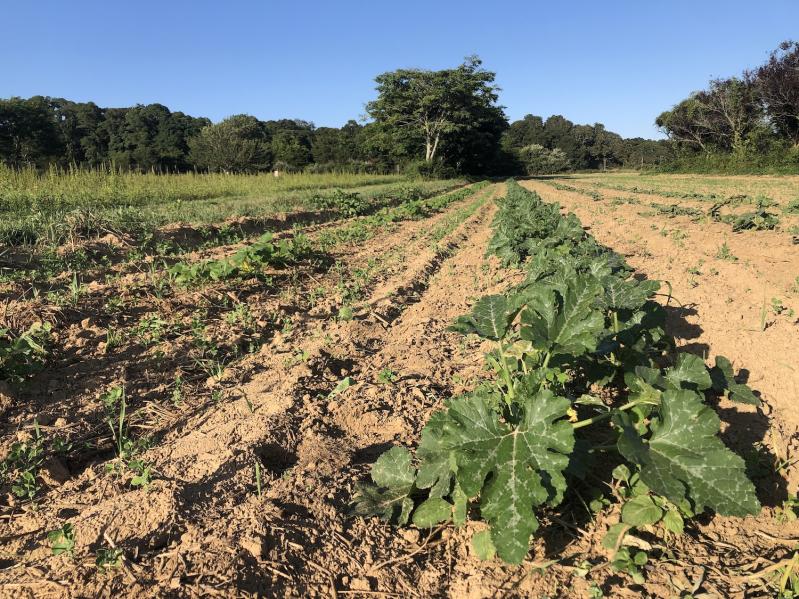While much of the South Fork of Long Island is now in a severe drought, according to the U.S. Drought Monitor, many East End residents have not changed their watering habits despite warnings from the Suffolk County Water Authority. Not so for East End farmers. For them, water is a factor in every decision they make about which crops to plant, and which to forgo.
Bette Lacina, of Dale and Bette Farms in Sag Harbor, said they chose not to water their flower crops this year so they could focus on growing food. Her partner, Dale Haubrich, grew up on a farm in Iowa. Minus a few years spent in the Army and college, he has farmed for over 60 years, so he has seen a drought or two. In a drought, crops with deeper root systems can hang on longer, he said.
"Corn can stand a bit of drought. The ear may be a bit smaller is all."
During dry weather, vegetables have relatively less water content, which affects their taste. "The corn, tomatoes, peppers, eggplant, and watermelon are all sweeter this year," he said. "Hot peppers are even hotter."
"We don't use water unless we have to," he said, but certain crops need irrigation. "Lettuces and Asian greens need water to keep them green and vibrant."
Farming for a lifetime has given him perspective. "The drought will end," he said. The development on the East End might not, though. Mr. Haubrich farms through the winters in Arizona. "Each spring we come back and see another old potato field growing houses," he said. "Water is important to farming, but so are fields."
Ian Calder-Piedmonte, a co-owner of Balsam Farms, says in 20 years of farming on the East End he has "never seen it this dry but, there's a lot of things I haven't seen." Most of their 100 acres have access to irrigation but their corn is growing completely dry and "it's working out." The drought has helped him learn more about the soil. "You start to learn that some sections of the field are sandier than others."
"Generally speaking, we're producing the same crops, but it would be better if it rains. One inch every Sunday night would be ideal," he said. However, he's not complaining. "If we don't have a hurricane in August, I'm happy."
Not every farm has irrigation. Regina Whitney, of Regina's Farm, has leased two acres of land from East Hampton Town for the last decade. She's smaller scale, selling at the East Hampton farmers market on Fridays and the Sag Harbor market on Saturdays. Nonetheless, the drought affects her just the same.
She doesn't use plastic covers to keep her crops damp. "When it did rain, the soil was thirsty, and it took the moisture very quickly," she said. Whitmores tree farm, which is adjacent to her fields, allowed her to use some water, but the drought has added hours to her day. "Sometimes I go to the fields at night to move the sprinklers around," she said.
She has even taken to watering her crops with a five-gallon watering can. "Sometimes I use two; one in each hand." She planted tall crops, like corn and sunflowers next to moisture-loving crops because they cast shade, allowing moisture retention.
Amber Waves Farm is in its 14th season, and in that time, Amanda Merrow, a co-owner, has watched it grow to 25 acres. Despite the name, only 20 percent of the acreage is planted with grain. "We had a really wet spring," she said, "which is what you want for grains. As you approach harvest, you want it to be dry." In other words, the current drought is helping grain yields.
Amber Waves has three fields, one that has no irrigation at all. She said the farm has grown winter squash there for seven years and it's never been a problem. The drought has changed that. "Our yields will certainly be down in that field this year," she said.
Apart from watering shortages, she said, drought impacts how farm equipment operates, and it can lead to intensified pest pressure, but it also might reduce certain diseases. Like other farmers, Ms. Merrow reported an absence of tomato blight.
Drought decreases predictability, and farmers like predictability.
Layton Guenther, the director of Quail Hill Farm in Amagansett, said it's not the hotter and drier stretches that are bothering them, but the inability to count on weather patterns. Drought means more time spent weeding, or irrigating, and less time selling or planting. Guenther worried about the long-term viability of the farm's wells, especially considering that farms share an aquifer with a population obsessed with evergreen landscapes.
Guenthers not the only one to worry. Ty Fuller is the lead hydrogeologist for the Suffolk County Water Authority. Over the phone he said "in certain parts of the South Fork over-pumpage could raise the potential for sea water intrusion into the aquifer. We want everybody to practice prudent and judicious use of their water resource."
Sometimes the drought just affects the quality of life. "I hate to use the D-word, 'dust,' but in general, it's less pleasant to farm when it's dusty and dry out there," said Ms. Merrow.
Unfortunately, the 10-day forecast shows little relief in sight.




